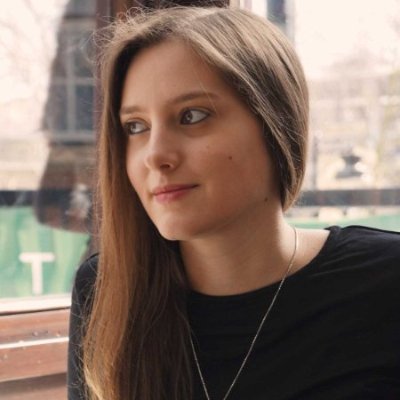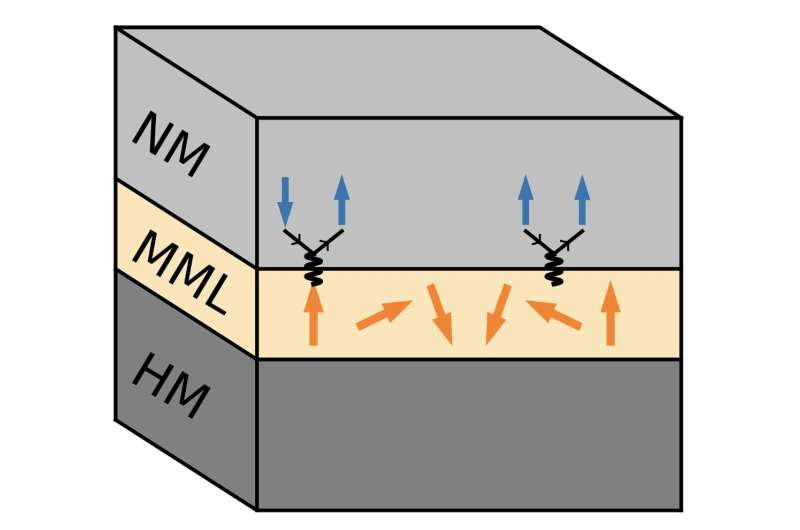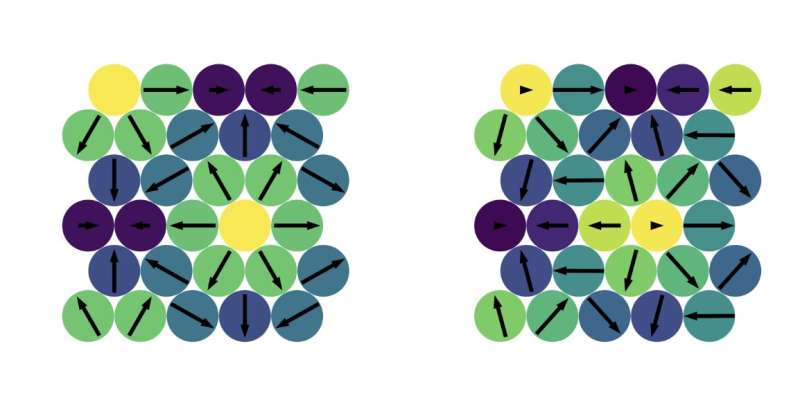April 28, 2023 feature
A model system of topological superconductivity mediated by skyrmionic magnons

Ingrid Fadelli
contributing writer

Topological superconductors are superconducting materials with unique characteristics, including the appearance of so-called in-gap Majorana states. These bound states can serve as qubits, making topological superconductors particularly promising for the creation of quantum computing technologies.
Some physicists have recently been exploring the potential for creating quantum systems that integrate superconductors with swirling configurations of atomic magnetic dipoles (spins), known as quantum skyrmion crystals. Most of these efforts suggested sandwiching quantum skyrmion crystals between superconductors to achieve topological superconductivity.
Kristian Mæland and Asle Sudbø, two researchers at the Norwegian University of Science and Technology, have recently proposed an alternative model system of topological superconductivity, which does not contain superconducting materials. This theoretical model, introduced in ������Ƶical Review Letters, would instead use a sandwich structure of a heavy metal, a magnetic insulator, and a normal metal, where the heavy metal induces a quantum skyrmion crystal in the magnetic insulator.
"We have been interested in low-dimensional novel types of quantum spin systems for a long time and were looking into the question of how quantum spin-fluctuations in quantum skyrmion crystals could affect normal metallic states and possibly lead to superconductivity of an unusual type," Sudbø told ������Ƶ.
"Previous work that in particular have inspired us and that we have been building on, is on realizations of quantum skyrmion crystals, and two of our own papers on quantum skyrmion crystals."
In , Stefan Heinze at University of Kiel and his colleagues at University of Hamburg showed that skyrmion crystals could be realized in actual physical systems. Inspired by the previous work by this research team, Sudbø and Mæland made a series of predictions, which serve as the basis of their newly proposed model system of topological superconductivity.

"We ourselves have not made these systems experimentally, but we are suggesting materials that could be used to create such systems and study their properties," Sudbø said. "We specifically studied a new way of creating topological superconductivity by sandwiching a normal metal with a very specific spin systems where the spins form skyrmions in a repeated pattern, a skyrmion crystal. Previous propositions for creating topological superconductivity suggested sandwiching skyrmion crystals with superconductors. Our approach obviates the need for a superconductor in the sandwich."
While they did not experimentally realize their proposed model system, Sudbø and Mæland tried to determine its properties through a series of calculations. Specifically, they calculated a property of the system's induced superconducting state, the so-called superconducting order parameter, and found that it had a non-trivial topology.
"We were able to create a model system where we can produce topological superconductivity in a heterostructure without having a superconductor a priori in the sandwich," Sudbø said. "Our system is sandwich structure of a normal metal and a magnetic insulator, while previous proposals have involved a sandwich structure of magnetic insulators and other superconductors."
In the future, new studies could try to realize the model system proposed by these researchers in an experimental setting, further examining its properties and potential for quantum computing applications. Meanwhile, Sudbø and Mæland plan to theoretically explore other possible routes to achieving unconventional superconductivity.
"In general terms, we will pursue unconventional superconductivity and routes to topological superconductivity in heterostructures of involving magnetic insulators with unusual and unconventional ground states as well as novel types of spin-excitations out of the ground state," Sudbø said.
Written for you by our author —this article is the result of careful human work. We rely on readers like you to keep independent science journalism alive. If this reporting matters to you, please consider a (especially monthly). You'll get an ad-free account as a thank-you.
More information: Kristian Mæland et al, Topological Superconductivity Mediated by Skyrmionic Magnons, ������Ƶical Review Letters (2023).
Journal information: ������Ƶical Review Letters
© 2023 Science X Network





















